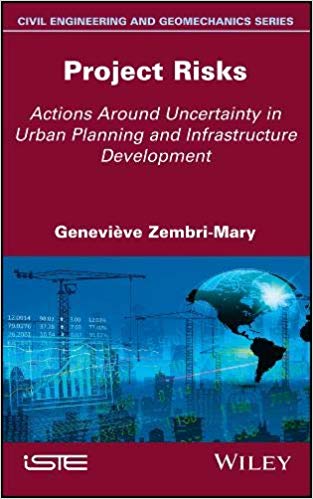图书简介
Those tasked with the planning and construction of infrastructure and development operations face an increasingly uncertain context in which they must address risks across a number of different fields. These range from the environmental and archaeological to the social, political and financial. As a consequence, the formal and informal practices of stakeholders often incorporate projections of risk and opportunity. Project Risks analyzes this paradigm shift. It reviews the origin and nature of these uncertainties, and the practices implemented by the actors to mitigate or take advantage of them. Paradoxically, these practices generate new risks and power relations that are not compatible with the collaborative planning model. These paradoxes force the rethinking of practices such as project territorialization, risk taking in planning and the responsibility of actors, as well as the societal and political choices that must be made between the realization of projects and the protection of the environment.
Introduction xi Chapter 1. The Uncertain Environment of Project Planning and Production Process 1 1.1. A risk society? 1 1.2. Globalization and uncertainty 3 1.3. The recent economic and financial crisis context 4 1.3.1. Crisis and mobility practices 4 1.3.2. A wait-and-see demand from households 4 1.3.3. The volatility of business locations 5 1.3.4. The impact of the crisis on the phasing of infrastructure projects 6 1.3.5. Phasing and flexibility of urban projects 7 1.3.6. For more flexibility, the project can precede the plan 7 1.3.7. The use of private financing by public-private partnerships 8 1.4. Environmental uncertainty 16 1.5. The need for stakeholders in the decision-making process to have access to unlimited information 17 1.6. The difficulty of making reliable forecasts for planning development projects 22 1.7. Multi-scalar and multi-objective planning 23 1.8. Participatory decision-making process and unpredictability 25 1.9. The social, environmental, and economic performance of the companies that carry out the projects 26 1.10. Conclusion 27 Chapter 2. How Can We Define Uncertainties and Risks? Risk from a Theoretical Point of View 29 2.1. Risks, uncertainties, hazards: disciplinary definitions 29 2.1.1. The notions of risk, hazard, and vulnerability in geography 29 2.1.2. The notions of risk, uncertainty, and hazard in project management 31 2.1.3. The notions of risk and uncertainty in economics 34 2.1.4. How does the public or private project owner use the concepts of risk and uncertainty? 35 2.2. Territorialized risks 35 2.3. Risk chains in time and space 36 2.4. \"Expert\" risk and perceived risk 37 2.5. Risk and opportunity 38 2.6. Uncertainties, risks, and opportunities external to the project 39 2.6.1. Characteristics of events that may impact a project or its social, natural, or economic environment (according to experts) 40 2.6.2. Political risk and opportunity 41 2.6.3. Risk and social opportunities 42 2.6.4. The risk and opportunity related to the choices and behaviors of residents and the economic environment 44 2.6.5. Risk and regulatory opportunity 45 2.6.6. Archeological risk and heritage opportunity 45 2.6.7. Environmental risk 46 2.6.8. Technological risk 47 2.6.9. Natural risk 48 2.6.10. Market risk 49 2.6.11. The risk of force majeure 49 2.7. Internal project risks 50 2.7.1. Construction risk 50 2.7.2. The risk of delay 50 2.7.3. Financial risk 51 2.7.4. Commercial risk 52 2.8. Conclusion 52 Chapter 3. Diachronic Approach to Taking Risks and Uncertainties into Account in Planning, Consultation, Evaluation, Financing, and Project Implementation Practices 55 3.1. Introduction 55 3.2. From the 1970s to the end of the 1980s: only natural and technological risks were addressed by the texts 56 3.2.1. The legal framework for environmental assessment and public participation excluded the concepts of risk and uncertainty 56 3.2.2. Only the concepts of foreseeable natural risk and major accident risk were regulated during the 1980s 61 3.2.3. Risk management still not very formalized as standards 62 3.3. The 1990s: taking into account social uncertainty for major infrastructure projects (transport, energy, etc.) 64 3.3.1. From the late 1980s to the early 1990s: the (para)public project owner managed social uncertainty by increasing public information by keeping control over the design and implementation of the project 64 3.3.2. The 1992 Bianco circular and the 1995 Barnier law allowed the public to participate in the public debate but were not always applied 67 3.4. 1997 to present: financial risk, risk to the project environment, social uncertainty, political risk, and traffic risk are gradually being integrated into the assessment process 69 3.4.1. A progressive and formalized consideration of risks in the evaluation process of infrastructure, development, and urban planning projects 69 3.4.2. The environmental assessment procedure is becoming more demanding and can be a source of risk for public and private project owners 97 3.4.3. A decision-making process driven by texts that seek to limit social and political risks 101 3.4.4. The socio-economic assessment process has integrated risks related to the technical and economic environment since 2005 107 3.5. Conclusion 112 Chapter 4. How do Risks Manifest Themselves in Projects? 113 4.1. Introduction 113 4.2. Political risk 115 4.2.1. High-speed lines 115 4.2.2. Urban planning projects 122 4.3. The environmental risk 131 4.3.1. The Langon-Pau highway (A65): a risk for vulnerable natural species insufficiently anticipated 131 4.3.2. The non-hazardous waste storage center in Nonant-Le-Pin (Eure): a risk of underground pollution and a health risk 135 4.3.3. The Espace Confluent in Reze (south of Nantes) or how to take advantage of a polluted urban wasteland 142 4.4. Social risk 145 4.4.1. The Lyon-Turin HSL: a very active cross-border opposition 145 4.4.2. Ile Seguin in Boulogne-Billancourt (Ile-de-France): years of recourse before mediation 153 4.5. Institutional risk 159 4.6. Archeological risk and heritage enhancement 162 4.7. Interface risks 164 4.8. Financial risk 166 4.8.1. The Perpignan-Figueras HSL: a lack of profitability 166 4.8.2. The Grand Paris Express: from additional charges to additional charges 172 4.8.3. Ile Seguin in Boulogne-Billancourt (Ile-de-France): the high cost of bearing the cost of land assets 176 4.9. Are there recurrences in terms of the succession of risks and uncertainties from one project to another? 178 4.9.1. Transport infrastructure projects 178 4.9.2. Development and urban planning projects 180 4.10. Conclusion: behind the risk, the actors 181 Chapter 5. Addressing or Taking Advantage of Risks Allows Actors to Build Power Relationships 183 5.1. Introduction 183 5.2. Mastering and using areas of uncertainty in the Sociology of Organizations 184 5.2.1. From the 2000s onward, research has shown that conflict can be seen as an opportunity and can reveal new uncertainties 184 5.2.2. The role of power relationships 185 5.2.3. The relationship between risk, uncertainty, and the interplay of actors 186 5.3. Addressing risk and areas of uncertainty to establish power relationships 188 5.3.1. Formalized anticipation of uncertainties and risks seems to have become a key practice 188 5.3.2. The method for socio-economically evaluating major transport projects is still more territorialized 189 5.3.3. The integrated study-concertation procedure is marked by benchmarks that can facilitate the decision-making process of transport infrastructure for the project owner 190 5.3.4. The contractualization of infrastructure and development projects implies the financial responsibility of the parties and, therefore, encourages them to treat and control risks 192 5.3.5. When the project precedes the plan: to adapt to market fluctuations or residents’ demands 194 5.3.6. Participatory planning of development and urban planning operations 197 5.4. Taking advantage of risk to have a source of power 199 5.4.1. The creation and use of areas of uncertainty by actors to build power relations 200 5.4.2. Actors implementing unpredictable behaviour to create doubt and uncertainty among other actors 211 5.5. Conclusion 220 Chapter 6. The Paradoxes of Project Planning and Management 223 6.1. Introduction 223 6.2. Flexible planning and project management offers opportunities but generates new risks 224 6.2.1. Flexibility of the decision-making, planning and project management process 224 6.2.2. The plasticity of the project and the production of new risks: the example of Meteor 228 6.2.3. Flexibility and risks 233 6.3. An inflation of rules that creates additional risks 233 6.3.1. A more precise legal framework for evaluation, consultation, financing, and contractualization 233 6.3.2. More rules and obligations for the private project owner and developer 234 6.3.3. More rules and more opportunities for appeals 235 6.3.4. Risks related to controversies for non-compliance with rules: risk of litigation (sometimes in a chain), risk of delay or termination of the project, risk of additional costs 238 6.3.5. The example of the consequences of the great national debate on the environment on the achievement of the A 65 Langon-Pau highway: litigation, delay, and additional costs 240 6.4. The paradoxes of theoretical reference planning models in relation to contemporary decision-making, planning, and project design practices 245 6.4.1. Reference planning models and their limitations 245 6.4.2. Positioning of contemporary planning and project design modalities in relation to theoretical models 252 6.5. Conclusion 260 Conclusion: Ways Forward for Action 261 Appendix: The Identification, Evaluation, Prioritization and Treatment of Risk by the Project Owner, Developer or Promoter 269 Glossary of Terms 273 References 277 Index 287
Trade Policy 买家须知
- 关于产品:
- ● 正版保障:本网站隶属于中国国际图书贸易集团公司,确保所有图书都是100%正版。
- ● 环保纸张:进口图书大多使用的都是环保轻型张,颜色偏黄,重量比较轻。
- ● 毛边版:即书翻页的地方,故意做成了参差不齐的样子,一般为精装版,更具收藏价值。
关于退换货:- 由于预订产品的特殊性,采购订单正式发订后,买方不得无故取消全部或部分产品的订购。
- 由于进口图书的特殊性,发生以下情况的,请直接拒收货物,由快递返回:
- ● 外包装破损/发错货/少发货/图书外观破损/图书配件不全(例如:光盘等)
并请在工作日通过电话400-008-1110联系我们。
- 签收后,如发生以下情况,请在签收后的5个工作日内联系客服办理退换货:
- ● 缺页/错页/错印/脱线
关于发货时间:- 一般情况下:
- ●【现货】 下单后48小时内由北京(库房)发出快递。
- ●【预订】【预售】下单后国外发货,到货时间预计5-8周左右,店铺默认中通快递,如需顺丰快递邮费到付。
- ● 需要开具发票的客户,发货时间可能在上述基础上再延后1-2个工作日(紧急发票需求,请联系010-68433105/3213);
- ● 如遇其他特殊原因,对发货时间有影响的,我们会第一时间在网站公告,敬请留意。
关于到货时间:- 由于进口图书入境入库后,都是委托第三方快递发货,所以我们只能保证在规定时间内发出,但无法为您保证确切的到货时间。
- ● 主要城市一般2-4天
- ● 偏远地区一般4-7天
关于接听咨询电话的时间:- 010-68433105/3213正常接听咨询电话的时间为:周一至周五上午8:30~下午5:00,周六、日及法定节假日休息,将无法接听来电,敬请谅解。
- 其它时间您也可以通过邮件联系我们:customer@readgo.cn,工作日会优先处理。
关于快递:- ● 已付款订单:主要由中通、宅急送负责派送,订单进度查询请拨打010-68433105/3213。
本书暂无推荐
本书暂无推荐
















